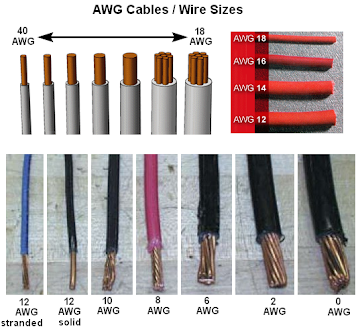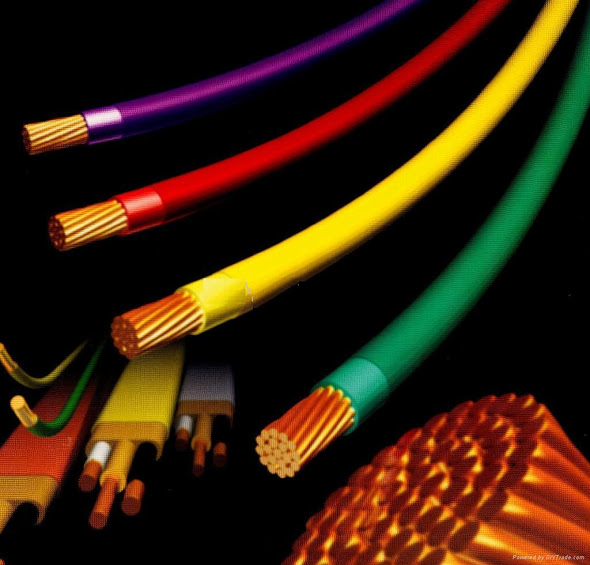Types of wires AWG
Types of wires AWG
Types of wires
The power cord is divided into two major types: Cables for low-voltage lights and for high-voltage lighting in this article will discuss the wires used in buildings, which are classified as low voltage cables. For Thailand Low voltage cables must be in accordance with TIS 11-2531 or TIS-11-2531 standards. In accordance with standards, low voltage cables will have many sizes. (Cross-sectional area) from small to large Which can withstand voltage from 300 volts to 750 volts. Power cables according to TIS 11-2531 standards will be divided into categories according to size Voltage resistance and usage are as follows
1 Ivy line (IV) This type of cable is a single wire or single core with a voltage rating of 300 volts. It is used as a walk-in cable for residential units that use a 1-phase system. Volts of use If the floating wiring must be fastened with insulating material or walk in the cable wiring in a dry place But do not directly bury the soil or bury the soil
2 VAF cable (VAF) is a 300 volt voltage-resistant cable. There are both single and double wire types. If it is a single wire, it is a round wire and if it is a 2-axis or 3-axis type, it is a flat wire. The conductor, in addition to being insulated, also has another layer of sheath. Follow the wall with a clip or walk in the wiring box But do not walk directly to the ground This type of underground wiring must be carried out in the earth buried pipe in the year to prevent water seeping In general residential homes, this type of cable is forbidden in 3-phase circuits with 380 volts as well (in 3-phase systems, but can be used as 1-phase, 220 volts voltage is available).
/span>
3 HW line (THW) is a 750V voltage-resistant electrical wire, which is a single wire, widely used especially in industrial plants Because it is used in normal three-phase electrical circuits The core of this type has a copper conductor. There are several wires, one large wire. The use is used to walk and float with a bracket made of insulating materials. Walk in the cabling Or walk in a buried ground pipe that has protection against water entering the pipe But do not bury the soil directly
4 (NYY) has both core types Single and multi-axis multi-core lines are also circular lines. This type of cable is resistant to pressure. 750 volts are also widely used because they are designed to be durable. The environment because there is another layer of shell for the single-line YYY type This type of wire has a single layer of insulation and has only one layer of shell. Prevent physical damage For multi-axis N-YY lines, may be called 3 insulated wiresIn fact, this type of wire has a single layer of insulation. The other two layers are the inner shells that act as a form. Each wire is threaded together until it has a round shape. And the outer shell is covered and another layer acts to prevent physical damage Multi-core NYY lines have 2-axis and 4-axis types depending on the requirements. This type of cord has two layers of shell as mentioned above. Type 4 (NYY-N) line The core has a neutrality line, also known as the NYY-N line (NYY-N), which has 3 wires and has one neutron line, with an estimated cross-sectional area. Half of the power line is suitable to be used in 3-phase 4-wire circuits. Another type is the NYY-Ground type cable (NYY-G), which is a 2-axis, 3-axis cable and 4-core wire (Groud ) Combined with another line, so it is suitable to be used to connect electrical equipment that must be connected to the ground All types of ligaments can walk underground directly because there is a chest layer that is resistant to the environment.
5 VCT line is a round wire with 1 axis, 2 cores, 3 cores and 4 cores. It can withstand 750 volts with insulating and peeling as well as YY cable. There is a special thing that the conductor is composed of a small amount of copper fringed into one axis. Making it have advantages that are weak and resistant to vibration It is suitable to be used as a cable to walk into machines that are vibrating while using this type of cable. It can be used as a general type of YY. In addition, there are VTC-VTC-Ground (VCT-G) cables. Which has 2 cores, 3 cores and 4 cores Electrical equipment that must be grounded VTC cable can walk directly to the ground
American Wire Gauge Conductor Size Table
American wire gauge (AWG) is a standardized wire gauge system for the diameters of round, solid, nonferrous, electrically conducting wire. The larger the AWG number or wire guage, the smaller the physical size of the wire. The smallest AWG size is 40 and the largest is 0000 (4/0). AWG general rules of thumb – for every 6 gauge decrease, the wire diameter doubles and for every 3 gauge decrease, the cross sectional area doubles. Note – W&M Wire Gauge, US Steel Wire Gauge and Music Wire Gauge are different systems.
American Wire Gauge (AWG) Sizes and Properties Chart / Table
Table 1 lists the AWG sizes for electrical cables / conductors. In addition to wire size, the table provides values load (current) carrying capacity, resistance and skin effects. The resistances and skin depth noted are for copper conductors. A detailed description of each conductor property is described below Table 1.
Table 1: American Wire Gauge (AWG) Cable / Conductor Sizes and Properties



